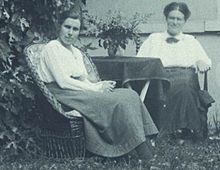Johanna Westerdijk
[1] Johanna Westerdijk, called "Hans" (Dutch pronunciation: [ɦɑns]) by friends,[1] was born on 4 January 1883 in Nieuwer-Amstel, a small village south of Amsterdam, and died on 15 November 1961 at 78 years old in Baarn, Netherlands.
Her interest in botany led her to attend Amsterdam University to follow the lectures of the famous botanist Hugo de Vries and work in his laboratory.
[2] In 1906, at 23 years old, she was offered a directorship position at Willie Commelin Scholten, a phytopathological laboratory in the Netherlands.
[3] While working as director of the phytopathological laboratory in 1908 she was in charge of keeping the International Association of Botanists collection of about 80 cultures of fungi.
[1] Westerdijk was described by journalists as a young, natural, simple, and strong woman with a pleasant manner and a great sense of humor.
She also had her own tradition at every new PhD ceremony, where a flag would be raised and three geese wearing white, red and blue bows around their necks would parade around the building.
[7] Later J. Westerdijk assigned another student, Christine Johanna Buisman to confirm the finding from Schwarz that Ophiostoma ulmi was the cause of the disease.



